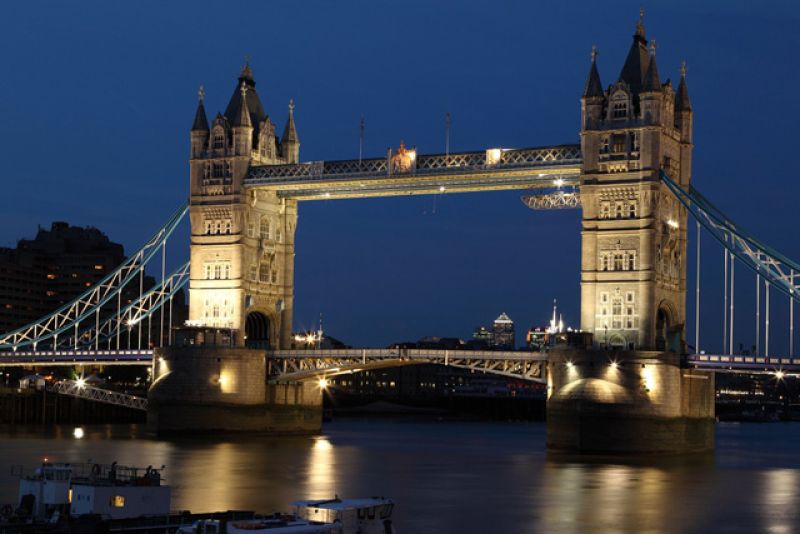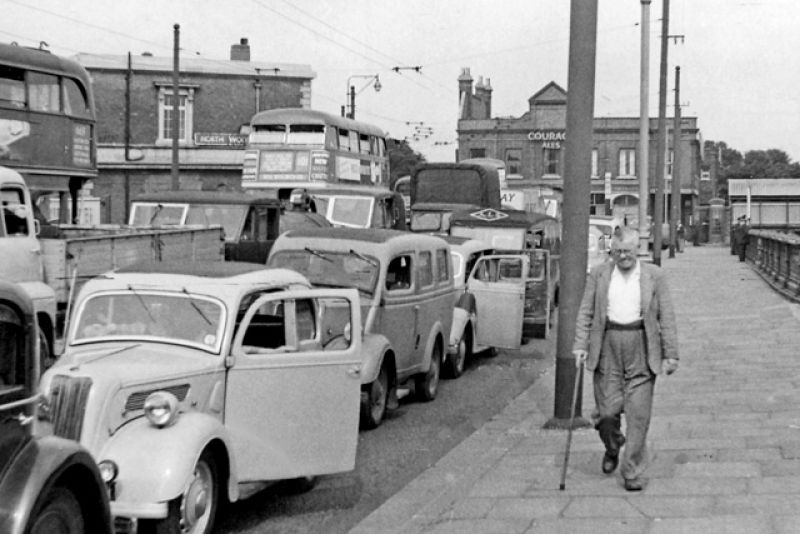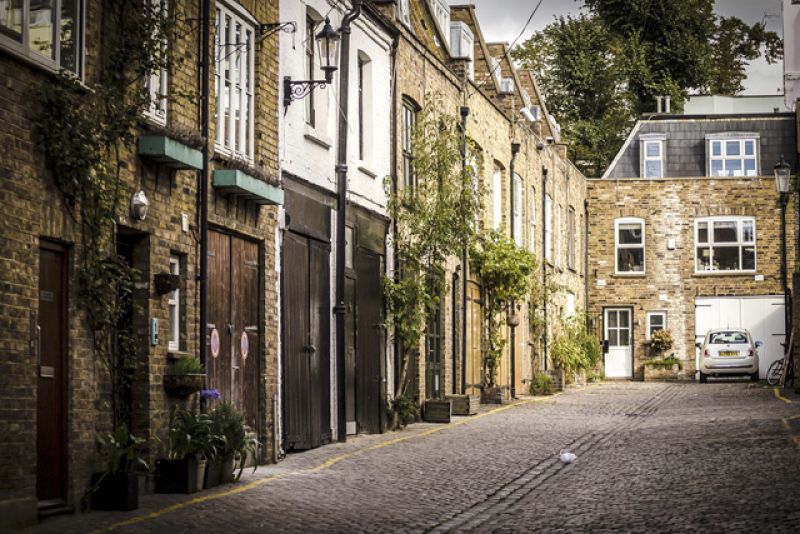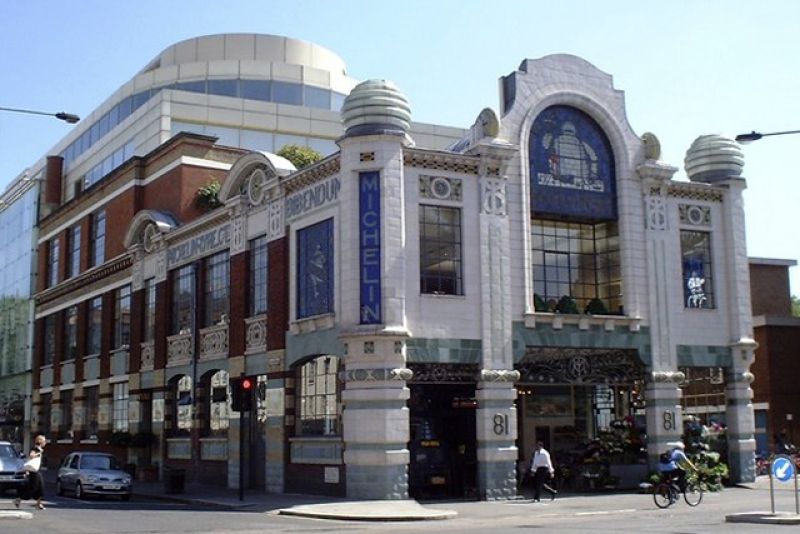Created Date:
Last Modified:
The Crystal Palace Circuit
Motor racing in the capital.
Location
Crystal Palace Park, Thicket Rd, SE19 2GA.
Date
1899, 1901, 1929, 1934, 1937-39, 1953-72, 1997-2000.
-
 Mike Hawthorn, driving a Maserati 250F, on his way to winning the British Automobile Racing Club’s race at the Palace, 30th July 1955, © National Motor Museum, Beaulieu
Mike Hawthorn, driving a Maserati 250F, on his way to winning the British Automobile Racing Club’s race at the Palace, 30th July 1955, © National Motor Museum, Beaulieu -
 Crystal Palace and Gardens, 1854; taken by Philip Henry Delamotte, source: Smithsonian Libraries
Crystal Palace and Gardens, 1854; taken by Philip Henry Delamotte, source: Smithsonian Libraries -
 About 40 vehicles lined up outside the Palace before the start of the competition, source: Autocar 13th May 1899
About 40 vehicles lined up outside the Palace before the start of the competition, source: Autocar 13th May 1899 -
 A 1902 advertisement for Decauville proclaiming the car’s achievement at Crystal Palace, source: Grace's Guide to British Industrial History
A 1902 advertisement for Decauville proclaiming the car’s achievement at Crystal Palace, source: Grace's Guide to British Industrial History -
 Organisers of the 1903 Motor Show at Crystal Palace claimed it to be the largest in the world, source: The Graphic, 7th February 1903
Organisers of the 1903 Motor Show at Crystal Palace claimed it to be the largest in the world, source: The Graphic, 7th February 1903 -
 Raymond Mays, in third place, leads Arthur Dobson, both driving E.R.As in the Imperial Trophy, Crystal Palace, 26th August 1939, © National Motor Museum, Beaulieu
Raymond Mays, in third place, leads Arthur Dobson, both driving E.R.As in the Imperial Trophy, Crystal Palace, 26th August 1939, © National Motor Museum, Beaulieu -
 The post-War circuit laid over a more recent view of the Park, © Alan Raine, via Flickr.
The post-War circuit laid over a more recent view of the Park, © Alan Raine, via Flickr. -
 Part of the Stadium Straight, taken in 2009, © Alan Raine, via Flickr
Part of the Stadium Straight, taken in 2009, © Alan Raine, via Flickr
Commentary
In 1852, work began on the relocation of the Crystal Palace from its exhibition site in London’s Hyde Park to the grounds of Penge Place, a manor house and gardens, covering almost 350 acres, near Sydenham in south east London.
Penge Place belonged to Leo Schuster, an entrepreneur and friend of Joseph Paxton, the Palace designer. 150 acres of the estate were sold to Joseph Paxton for a housing development, and the remaining 200 acres given over to what became known as Crystal Palace Park, with the remodelled Palace, terraces and fountains as its centre piece.
The Palace and Park opened in 1854 and, in the years that followed, they became important places of entertainment and culture. Between 1854 and 1884, visitor numbers averaged about two million people a year.
Towards the end of the 19th century, they also became a significant sports venue. In 1894-5, a football stadium was built inside the Park and, from 1895 until the outbreak of the First World War, it hosted the English F.A Cup Final.
Motor sport reached Crystal Palace on the 5th May 1899 in the form of a series of ‘controlled tests’ for motor cycles and cars, organised by the Motor Car Club. Vehicles were divided into five classes, two for motorcycles, and three for cars (light, heavy and heavy delivery vans).
The two-mile course ran over some of the twistiest and steepest sections of the Park, and competitors were required to stop their vehicles ‘dead’ at six designated points. Drivers who stopped outside the flags or on the ascent were disqualified.
Perhaps it was because so many of the competitors reportedly ground to a halt on the steep slopes that the organisers announced that the results would not be published until the following day. In fact, they don’t appear to have been published at all. However, we do know that the competitors included E Campbell-Muir, driving a Daimler Grafton Phaeton, H J Lawson, one of Britain’s motoring pioneers, and Charles Rolls, driving (as reported in the Wrexham Advertiser) “a red racing car, built in France, which seemed as swift as it was certainly ugly”. (It was a Panhard.)
Over the next two years, most – if not all – motor races at the Palace seem to have been for motorised cycles and tricycles, often involving two great pioneers of British motoring, Selwyn Edge and Charles Jarrott. However, in his autobiography, ‘My Motoring Reminiscences’, Selwyn Edge describes an unusual motoring event that took place on the Crystal Palace track in November 1900.
Organised by their English agent, the French Decauville car company, better known for manufacturing locomotives, arranged for two of their cars, an eight h.p twin-cylinder model, and a smaller five h.p car, to complete a 1,000 mile non-stop journey around the Crystal Palace track.
On 21st November 1900 at 9.27 am, on a bitterly cold day, the larger car began its long journey around the oval track, originally designed for cycle racing, measuring three laps to the mile. The smaller car began the test ten minutes later.
After 312.25 miles, the larger car came to a halt – its carburettor “a solid block of ice”. Fourteen minutes later, it was back on the move, but after just a further mile-and-three-quarters, the problem recurred. It was nine hours before the car started again, but there were no further breakdowns. However, the mission came perilously close to disaster towards the end of the event when a lamp, standing on the rear of the car, overturned setting light to the car’s petrol supply. “The car ran around the track for a lap or two like a veritable pillar of fire,” Edge wrote, “The keen and active French mechanics were quickly aboard with smothering cloths and the conflagration was extinguished.” The last 621 miles were completed at an average speed of 24.93 mph.
The smaller car also had a number of problems; one requiring a mechanic to replace an inlet valve, as the car continued to lap the track for a distance of eight miles, albeit on one cylinder in pitch darkness - during the early hours of the morning.
The next motor racing at the Palace was in April 1901, in front of a crowd of 50,000. It was at this event that the track’s first recorded ‘motor smash’ occurred, involving Cecil Edge, Selwyn’s cousin. A broken front wheel spindle caused his De Dion tricycle to clear the outer fence, knocking three people off the barrier in the process. Fortunately, no one was hurt. The one-mile car race was won by Charles Jarrott in an 8 h.p Panhard, with Harry (HJ) Lawson, also driving a Panhard, in second place.
Over the next ten years, the track hosted many events for cycles and motorcycles, but few, if any, motor races. The presence of cars at Crystal Palace seems to have been restricted to exhibitions and motor shows, with the track being used for test drives.
Falling attendances and insufficient revenue led to the Palace going into administration in May 1909, but in November 1911, the buildings and grounds were bought for £210,000 by the Earl of Plymouth, a one-time vice president of the Motor Union of Great Britain and Ireland. However, a fund was immediately set up to relieve Lord Plymouth of his financial responsibility, and in 1913, the Palace became the property of the nation.
With the onset of the First World War a year later, the Palace was used as a naval training establishment. It re-opened in 1920 becoming, for the following four years, the original site of the Imperial War Museum.
Motor cycle racing returned to the Palace in May 1927, and for the next seven years there were regular meetings for solo motorcycles and sidecars. However, for the evening meeting on Wednesday 21st August 1929, a motor race was included on the programme for the first time. Entries were restricted to cars under 900cc.
There was at least one further race of this kind in November 1929, with a number of the drivers also competing in motorcycle and sidecar events at the same meeting. In January 1934, specially constructed midget cars were raced on Palace’s Speedway circuit – but this seems to have been relatively short-lived.
However, just over two years later, in August 1936, much more ambitious plans were announced for a completely new track within the Palace grounds: a two-mile circuit with “a straight section of approximately half a mile, fast corners, hairpin bends, and rises and falls”.
Despite the devastating fire on 30th November 1936, which completely destroyed the Palace, the new circuit was finished on time, with the first race - the Coronation Cup – taking place on the 24th April 1937.
Open to cars up to 1500cc, it comprised of two heats of 40 miles each and a final of 60 miles, and was won by Pat Fairfield, driving Humphrey Cook’s supercharged E.R.A. The event drew more than 50,000 spectators, with parking causing major problems for local residents; one newspaper reporting that there were more casualties outside the track than on it.
Over the next two years, an extensive programme of motor racing was held at the new circuit. With six major meetings in 1938 (and five in 1939), the road track drew many of the world’s top motor racing drivers, including: George Abecassis, Prince Birabongse of Siam, Arthur Dobson, Raymond Mays, and Tony Rolt. A race meeting for mini-cars was run on the 6th August 1938; advertised as a doodlebug race.
During the Second World War, the Palace Gardens and buildings contained an anti-aircraft installation, a military depot, allotments, and accommodation for refugees and French sailors.
In January 1949, it was announced that motor racing would return to the Palace; and, over the next four years the track was repaired and modified, shortening the circuit length to 1.39 miles.
Racing resumed on 25th May 1953. In front of a crowd estimated to be “well over 50,000”, Stirling Moss, driving a Cooper, won the 500cc event, and Tony Rolt took the Coronation Trophy in a Connaught. Both races were broadcast by the BBC.
There were two further meetings during the remainder of the year and, for the next seven years, there were usually five large meetings each year, with races for 500cc, Formula Two, Formula Three, and sports cars. Formula One came to the Palace in 1955, and the first Touring Car races held on Whit Monday 1959. Over this period, drivers at the circuit included: Cliff Allison, Jack Brabham, Ivor Bueb, Colin Chapman, Peter Collins, Bernie Ecclestone, Mike Hawthorn, Graham Hill, Roy Salvadori, Carroll Shelby, and of course, Stirling Moss – to name but a few.
As far back as 1954, plans had been announced to develop a National Youth and Sports Centre at Crystal Palace. The project finally got underway in 1959 and, in July 1964, the National Recreation Centre was opened by the Duke of Edinburgh.
Although it was now sharing the Park with a substantial athletics facility, the track underwent a number of improvements during this period, settling down into a pattern of usually two or three large meetings a year.
The circuit continued to attract current and future stars, such as Jim Clark, Bruce McLaren, Jochen Rindt, Jackie Stewart and John Surtees.
In 1970, historic restrictions on the number of meetings permitted at the track expired, and the circuit’s owners, the Greater London Council, raised the number of meeting for the coming year to fourteen.
However, this proved to be short-lived; two years later, in 1972, a decision was made to close the circuit in order to allow further development of athletics and other sports on the site. The final meeting took place on the 23rd September 1972, a historic meeting, organised by the Aston Martin Owners’ Club. The last race to be held was won by Gerry Marshall, driving a Lister-Jaguar.
Since the closure of the circuit, Crystal Palace has hosted a couple of rallying events, together with a two-day speed trial, held each year between 1997 and 2000, organised by the Sevenoaks & District Motor Club.
Further details
• Motor Racing at Crystal Palace: London’s Own Circuit, S.S. Collins, Veloce Publishing, 2005.
• Motorsport Explorer, Julian Hunt, Haynes Publishing, 2012.
• Motor Racing Circuits in England: Then and Now, Peter Swinger, Ian Allan, 2001.











